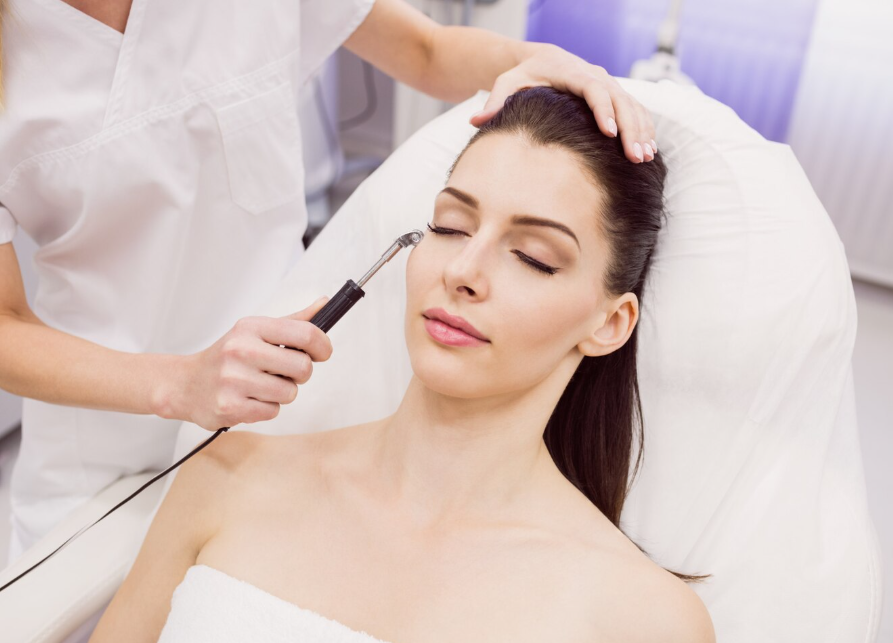Treatment Overview
The CO₂ Fractional Laser is an ablative resurfacing laser operating at 10,600 nm wavelength. It works by creating controlled micro-injury zones in the skin, vaporizing damaged tissue while stimulating collagen renewal and epidermal turnover.
In Korea, the CO₂ Fractional Laser is not typically the first-line treatment for melasma, since melasma is sensitive and prone to recurrence. However, it is sometimes used in combination therapy for patients with mixed melasma (epidermal + dermal) or melasma with significant textural irregularities, scarring, or enlarged pores. By resurfacing the skin, it allows better penetration of topical whitening agents and adjunctive treatments, while helping with texture and scar remodeling.
It belongs to the Pigmentation Treatment family (CO₂ Fractional, Nd:YAG, Dual Toning, Gold Toning, Pico Lasers, Clear + Brilliant):
- CO₂ Fractional: Best for melasma with texture + scars (not stand-alone for melasma).
- Nd:YAG Laser Toning: Best for dermal melasma.
- Dual Toning: Best for multi-layer melasma.
- Gold Toning: Best for vascular melasma.
- Pico Lasers: Best for resistant melasma and PIH.
- Clear + Brilliant: Best for mild melasma and maintenance.
Purpose & Benefits
- Melasma Support: Helps lighten epidermal pigmentation when combined with toning lasers.
- Improved Penetration: Increases absorption of whitening agents and serums.
- Collagen Remodeling: Improves fine lines, acne scars, and skin firmness.
- Texture Refinement: Smooths roughness and reduces pore size.
- Skin Rejuvenation: Promotes long-term skin regeneration.
Ideal Candidates
CO₂ Fractional Laser in Korea is recommended for:
- Adults with melasma complicated by scarring, rough texture, or enlarged pores.
- Patients who want combination therapy for deeper melasma control.
- Individuals seeking collagen stimulation alongside pigment reduction.
- Men and women comparing treatments:
- CO₂ Fractional: Best for melasma + scarring + texture.
- Nd:YAG: Best for dermal melasma.
- Dual Toning: Best for multi-layer melasma.
- Gold Toning: Best for vascular-linked pigmentation.
- Pico Lasers: Best for resistant pigmentation.
- Clear + Brilliant: Best for preventive and maintenance care.
Possible Risks & Complications
CO₂ Fractional is more aggressive than non-ablative lasers, and for melasma patients, risks must be carefully managed:
- Redness & Swelling: May last several days.
- Crusting & Flaking: Normal healing process for resurfacing.
- PIH (Post-Inflammatory Hyperpigmentation): A risk in melasma patients if not performed conservatively.
- Rare Risks: Hypopigmentation or scarring (rare in expert Korean clinics).
Surgical Techniques Used
The CO₂ Fractional Laser uses ablative fractional resurfacing:
- 10,600 nm Wavelength: Removes damaged epidermis and stimulates dermal remodeling.
- Fractional Microthermal Zones: Promote faster healing compared to traditional CO₂.
- Combination Therapy: Often paired with Nd:YAG toning, Pico lasers, or topical whitening programs for melasma.
- Protocol: 1–3 sessions spaced 2–3 months apart; cautious settings for melasma patients.
Recovery & Aftercare
- Immediately: Redness, swelling, and sensitivity.
- 2–5 Days: Crusting, flaking, or peeling.
- 1–2 Weeks: Skin heals with improved texture and lightened pigment.
Aftercare Tips:
- Apply healing ointments and barrier creams.
- Use SPF 50+ sunscreen daily (essential for melasma patients).
- Avoid picking or scratching healing skin.
- Avoid harsh products (retinoids, acids, scrubs) until skin recovers.
Results & Longevity
- After First Session: Brighter, smoother skin; mild pigment lightening.
- Short-Term (1–2 Sessions): Improved skin texture and reduced surface pigmentation.
- Medium-Term (2–3 Sessions): Enhanced melasma outcomes when combined with other lasers.
- Long-Term: Maintenance with Nd:YAG or Pico Lasers recommended to prevent recurrence.
Treatment Process in Korea
- Consultation & Skin Analysis – Doctor evaluates melasma depth, type, and skin condition.
- Preparation – Cleansing, numbing cream, and protective eyewear.
- CO₂ Fractional Session – Controlled fractional beams applied to melasma-affected areas.
- Post-Care: Cooling mask, soothing ointments, and hydrating serums.
- Follow-Up: Multi-modal plan combining CO₂ with melasma-specific lasers.
Why Korea is a Top Destination
- Korea’s dermatologists are highly skilled in melasma-safe CO₂ protocols.
- Clinics combine CO₂ with Nd:YAG, Dual Toning, or Pico Lasers for holistic melasma treatment.
- Affordable compared to Western resurfacing treatments.
- Many Korean clinics integrate CO₂ with regenerative boosters (Rejuran, exosomes, PN) for improved healing.
- Seoul is globally recognized for pigmentation and scar treatment expertise.
Cost Range (Detailed Breakdown)
Pricing for CO₂ Fractional Laser in Korea:
- Single Session (full face): USD 250 – 500
- 2–3 Session Package: USD 600 – 1,500
- Premium Package (CO₂ + Nd:YAG/Pico + Boosters): USD 1,200 – 3,000
Additional Costs in Korea:
- Consultation: USD 20 – 50
- Add-ons (Rejuran, exosomes, whitening drips, PN boosters): USD 100 – 500
💡 For melasma, the CO₂ Fractional Laser is best as a supportive treatment — improving texture, scars, and topical absorption, while stronger pigment-targeting lasers like Nd:YAG or Pico remain the main therapy.
Popular Clinics
- Banobagi Dermatology (Seoul): CO₂ + Nd:YAG protocols for melasma + scarring.
- Oracle Dermatology (Seoul): CO₂ for texture + Pico for pigment control.
- Renewme Skin Clinic (Seoul): Fractional CO₂ with boosters for melasma + PIH.
- View Plastic & Dermatology (Seoul): Combination CO₂ + Dual Toning for stubborn melasma.
- Chaum Anti-Aging Center (Seoul): Premium CO₂ melasma programs with regenerative add-ons.




